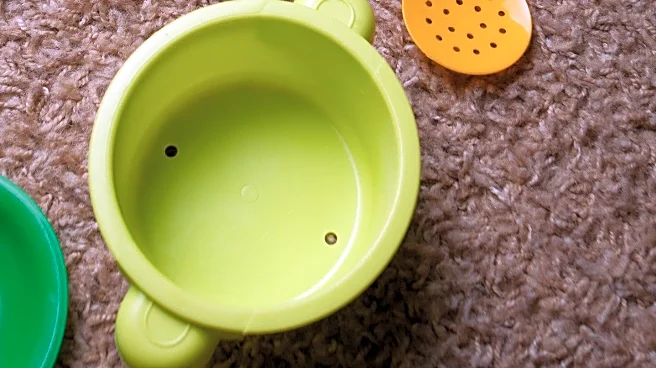What's Happening?
Recent findings have highlighted the presence of microplastics in common kitchen items, raising concerns about their potential health impacts. Americans are estimated to consume between 39,000 to 52,000 microplastic particles annually through food, water,
and kitchen utensils. Microplastics, which are less than 5mm in length, have been associated with various health issues, including cell damage and weakened immune systems. Studies have shown that plastic containers, especially when used in microwaves, can release significant amounts of microplastics into food. Additionally, plastic kitchen utensils and tea bags have been identified as sources of microplastic exposure. The article suggests replacing plastic items with alternatives made of glass, metal, or wood to mitigate these risks.
Why It's Important?
The potential health risks associated with microplastic exposure are significant, as they may contribute to long-term health issues such as organ damage and cancer. This revelation is crucial for public health, prompting consumers to reconsider their use of plastic kitchen items. The shift towards non-plastic alternatives could lead to changes in consumer behavior and influence manufacturers to produce safer products. As awareness grows, there may be increased demand for regulatory measures to ensure the safety of food contact materials, impacting industries involved in kitchenware production and food packaging.
What's Next?
Consumers are likely to start replacing plastic kitchen items with safer alternatives, such as glass or metal, to reduce microplastic exposure. This trend could drive innovation in the kitchenware industry, with companies developing new products that prioritize health and safety. Regulatory bodies may also consider implementing stricter guidelines for food contact materials to protect public health. As research continues, further studies may provide more definitive evidence on the health impacts of microplastics, potentially leading to broader policy changes.
Beyond the Headlines
The issue of microplastics in kitchen items underscores broader environmental concerns, as plastic pollution remains a significant challenge globally. Efforts to reduce plastic use in households could contribute to larger environmental sustainability goals. Additionally, this development may spark discussions on the ethical responsibilities of manufacturers in ensuring product safety and transparency. Long-term, the shift away from plastic could influence cultural attitudes towards consumption and waste, promoting more sustainable living practices.













